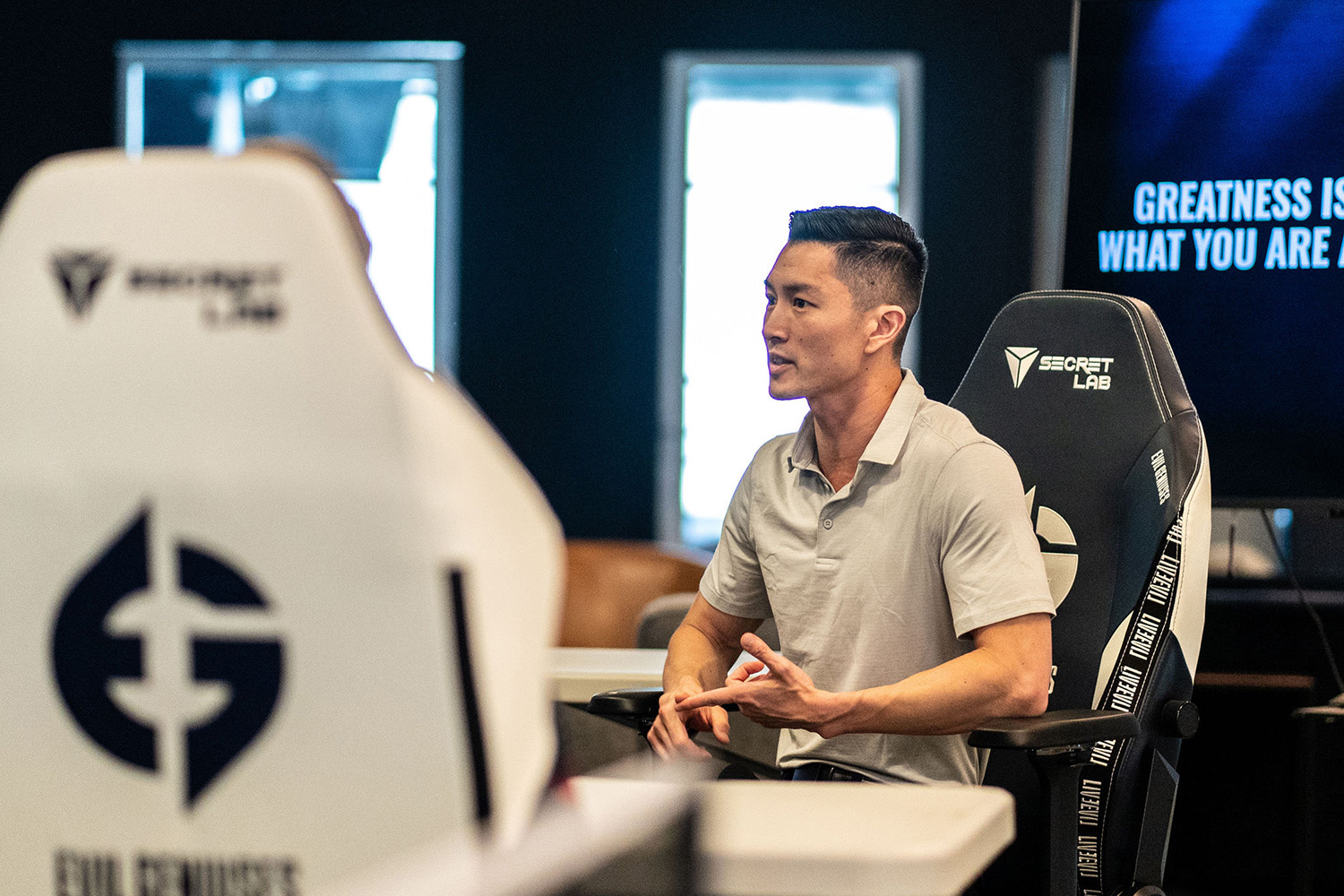11.15.2023
By uscbknpt
Game On!

USC alumnus Jordan Tsai found a way to combine his lifelong love for gaming with his physical therapy education to build a unique career.
BY JAMIE WETHERBE
JORDAN TSAI DPT ’18 HAS BEEN HOOKED ON GAMING since the age of 5. In an effort to combine his career with his passion, Tsai has focused on a niche — but growing — patient population, esports athletes.
Over the past five years, Tsai has worked with numerous professional esports teams and has treated professional players across a variety of games, from Fortnite to World of Warcraft, teaching specific strategies to play pain-free.
A U.S. Army Veteran, Tsai collaborates with designers to create ergonomic chairs, specifically suited for players’ needs. Always game for screen time, Tsai creates content on healthy gaming habits, strategies to optimize physical wellness and tips to ensure peak performance — at every level of play. We caught up with the alumnus for a Q-and-A about his professional journey.
This is such a unique patient population — how did you get into this field?
My goal was to pursue something different, and gaming has always been an interest of mine. I felt the field of esports could benefit from my knowledge and skillset — plus, I’m in Los Angeles, the hub for North American esports. I started by putting out social media content related to health and wellness in gamers, and later, started working directly with professional organizations. I expanded that role into a more regular weekly schedule with an emphasis on ”prehab” strategies as most gaming injuries are related to overuse and are preventable. Gaining recognition from my work with pros, I began working with streamers and gamers of all levels.
What are some examples of prehab strategies?
Mainly ergonomics, and preventive stretching and strengthening exercises. I’m also a consultant for SecretLab, which engineers ergonomic chairs specifically for gaming. I offer research to support better chair design and create content to educate gamers on how to sit properly. Much of the current literature and practices in ergonomics don’t apply to gamers because they fundamentally play in a very different position than how we typically work at a desk.
What are the ages of the patients you typically see?
Between the ages of 18 and 30.
What types of injuries do you see most?
I primarily work with keyboard/mouse players, so forearm tendinopathies are the most common injuries, followed by ulnar nerve irritation. I also often see low back and neck pain as a result of poor posture while playing long hours. Unlike sedentary desk workers, I’ve actually never seen carpal tunnel in a professional player.
What are the types of treatments you recommend to patients?
Most injuries are related to overuse, so I do a lot of manual therapies to address muscle length, joint mobilization, tension issues and sensitivity. I also encourage exercise interventions based on habit. For instance, giving gamers two stretches to do between games and maybe one light strengthening exercise. I try to keep recommendations minimal because, as a population, gamers are unlikely to stick to a full rehab program. I want to provide preventive habits so gamers never get to a point where they have an injury — that’s the goal.
What are some considerations this population has that others might not?
I don’t often have the luxury of recommending “rest” from gaming as a means of reducing symptoms. Many pros and streamers have to play a certain number of hours a week as a part of their job, so my solutions must account for that. They’re often also not used to exercise in general, so I encourage them to transition to a more active lifestyle, which can be challenging. I rarely change a player’s “form” while playing, unless it’s directly related to current symptoms. A change in how they play will inevitably cause patients to suffer a drop in performance.
How did USC set you up for success?
USC provided me with an excellent baseline education in PT that allowed me to start working out of school with confidence. I pursued my orthopedic clinical specialty, while working in the clinic and simultaneously launched my esports endeavors — a move only possible because my foundation in orthopedic physical therapy was strong.
You’re also a veteran — how did that experience prepare you for this type of work?
I served as a combat medic in the Army and went on a single tour of duty in Baghdad. That experience prepared me for the stress of school, while also providing me with a solid knowledge base for entering the medical field. It also refined my ability for thinking outside of the box when it comes to unusual problems, incredibly important as an entrepreneur and physical therapist. I owe a lot to the military for changing my perspective on life in general. Every day, I am appreciative of the time I have here.
Any favorite games?
I love strategy games, RPGs (role-playing games) and competitive games. Currently, I play a lot of Baldur’s Gate 3, League of Legends and Slay the Spire. I stream regularly on Twitch (DocRespawn), while offering health and wellness content with other streamers when I can.

